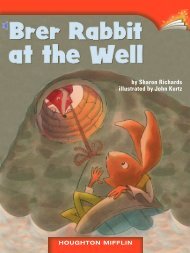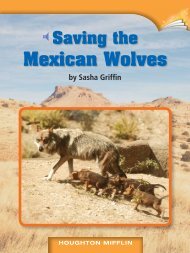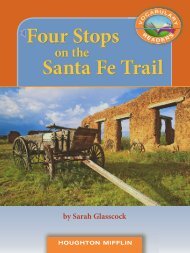Lesson 13:Louise Arner Boyd and Glaciers
Lesson 13:Louise Arner Boyd and Glaciers
Lesson 13:Louise Arner Boyd and Glaciers
Create successful ePaper yourself
Turn your PDF publications into a flip-book with our unique Google optimized e-Paper software.
HOUGHTON MIFFLIN
By Dan Rosen<br />
ILLUSTRATION CREDITS: 6 Joe LeMonnier / Melissa Turk; 14 Studio Montage; 16 Mike Maydak / Craven Design<br />
PHOTOGRAPHY CREDITS: Cover © Bettmann / CORBIS; 1 © Bettmann / CORBIS; 2 © Hemera Technologies ; 3 © Bettmann<br />
/ CORBIS; 5 © Hans Str<strong>and</strong> / CORBIS; 7 © Pictorial Press Ltd / Alamy; 10-11 © Bettmann / CORBIS; 17 (bottom left <strong>and</strong><br />
bottom right) © NSIDC/WDC for Glaciology, Boulder, compiler; Bkgrnd © PhotoDisc / Elements<br />
Copyright © by Houghton Mifflin Harcourt Publishing Company<br />
All rights reserved. No part of this work may be reproduced or transmitted in any form or by any means, electronic or<br />
mechanical, including photocopying or recording, or by any information storage <strong>and</strong> retrieval system, without the prior<br />
written permission of the copyright owner unless such copying is expressly permitted by federal copyright law. Requests<br />
for permission to make copies of any part of the work should be addressed to Houghton Mifflin Harcourt School Publishers,<br />
Attn: Permissions, 6277 Sea Harbor Drive, Orl<strong>and</strong>o, Florida 32887-6777.<br />
Printed in China<br />
ISBN-<strong>13</strong>: 978-0-547-02510-0<br />
ISBN-10: 0-547-02510-6<br />
1 2 3 4 5 6 7 8 0940 18 17 16 15 14 <strong>13</strong> 12 11<br />
If you have received these materials as examination copies free of charge, Houghton Mifflin Harcourt School Publishers<br />
retains title to the materials <strong>and</strong> they may not be resold. Resale of examination copies is strictly prohibited.<br />
Possession of this publication in print format does not entitle users to convert this publication, or any portion of it, into<br />
electronic format.
Table of Contents<br />
Introduction . . . . . . . . . . . . . . . . . . . . . . . . . . . . . . . . . . . . . . . . . 3<br />
Chapter 1: Finding the Arctic. . . . . . . . . . . . . . . . . . . . . . . . . . 4<br />
Chapter 2: Exploring the Arctic. . . . . . . . . . . . . . . . . . . . . . . . 6<br />
Chapter 3: Dealing with Danger . . . . . . . . . . . . . . . . . . . . . . 10<br />
Chapter 4: <strong>Glaciers</strong> . . . . . . . . . . . . . . . . . . . . . . . . . . . . . . . . . <strong>13</strong><br />
Index . . . . . . . . . . . . . . . . . . . . . . . . . . . . . . . . . . . . . . . . . . . . . . . 18
Introduction<br />
Do you have an interest or hobby that others think is<br />
unusual? Do you think it would make a good story? This book<br />
tells about a very unique woman, <strong>Louise</strong> <strong>Arner</strong> <strong>Boyd</strong>, <strong>and</strong> her<br />
even more unusual interest, exploring Arctic l<strong>and</strong>s <strong>and</strong> glaciers.<br />
Why was <strong>Boyd</strong>’s interest unusual? First, <strong>Boyd</strong> was born<br />
in California, far from the Arctic. Second, <strong>Boyd</strong> was born in<br />
1887, a time when women were not<br />
expected to have professions.<br />
And they certainly were not<br />
expected to do anything<br />
involving physical danger like<br />
exploring the Arctic.<br />
Also unusual, was how<br />
little was known about the<br />
Arctic <strong>and</strong> glaciers in general<br />
at the time. Robert Peary was<br />
the first person to reach the<br />
North Pole, but he did not do<br />
so until 1909. Ice-filled seas<br />
made exploring the Arctic<br />
extremely dangerous.<br />
<strong>Boyd</strong> was born into<br />
a wealthy family.<br />
3
Chapter 1<br />
Finding the Arctic<br />
<strong>Louise</strong> <strong>Arner</strong> <strong>Boyd</strong>’s life was not like that of most people.<br />
As a child, <strong>Boyd</strong>’s favorite activity was riding horses with her<br />
brothers on their father’s ranch. But her childhood was scarred<br />
by tragedy. Both brothers died in their teens from rheumatic<br />
fever. Her parents never recovered from their deaths. Then,<br />
when <strong>Boyd</strong> was in her early thirties, both her parents died.<br />
<strong>Boyd</strong> inherited her family’s fortune <strong>and</strong> investment business.<br />
<strong>Boyd</strong> continued living in her parents’ mansion in San<br />
Rafael, California, by herself. She attended luncheons, parties,<br />
<strong>and</strong> the opera — all things expected of wealthy women of<br />
her time. However, she grew bored of this life, so she began<br />
traveling. In 1924, after several trips to Europe, <strong>Boyd</strong> traveled to<br />
the isl<strong>and</strong> of Spitsbergen, a part of Norway in the Arctic Ocean.<br />
It was her first view of the far North. She was deeply moved by<br />
the vast expanse of the frigid Arctic Ocean. <strong>Boyd</strong> had come to<br />
the isl<strong>and</strong> because she was bored. She left knowing what she<br />
wanted to do with the rest of her life. She resolved to explore<br />
the Arctic.<br />
For just about any other person, <strong>Boyd</strong>’s wish would remain<br />
just that, a wish. But <strong>Louise</strong> <strong>Boyd</strong> was different. She had no use<br />
for conventions, or unstated social rules, <strong>and</strong> did not care what<br />
other people thought. Once she set a goal, she was determined<br />
to reach it. <strong>Boyd</strong> was also financially able to make her wish<br />
come true.<br />
4
<strong>Boyd</strong> began planning an expedition to the Arctic. First, she<br />
wanted to prime herself for the trip by learning more about this<br />
fascinating place. She hired one of the most famous experts on<br />
the Arctic to instruct her. <strong>Boyd</strong> also trained to become a nature<br />
photographer. In the 1920s, cameras could not be held in one<br />
h<strong>and</strong>. A photographer needed to learn how to operate the large,<br />
box-like cameras used at the time. <strong>Boyd</strong> also trained with a<br />
scientist so she could collect plant specimens in the Arctic.<br />
<strong>Boyd</strong> explored Artic regions like the one shown<br />
here. Notice the icepack, or floating sea ice.<br />
5
Chapter 2<br />
Exploring the Arctic<br />
In 1926, <strong>Boyd</strong> was finally ready. Her first trip to the Arctic<br />
was the culmination of months of training. <strong>Boyd</strong> hired a boat<br />
called the Hobby that was specially equipped to navigate the<br />
Arctic ice. The Hobby had been used before to carry supplies<br />
to explorers in the Arctic. <strong>Boyd</strong> planned to take photographs<br />
during her first trip. She invited friends to join her.<br />
The Hobby first sailed to the huge isl<strong>and</strong> of Greenl<strong>and</strong>,<br />
which is largely covered with glaciers. They came ashore in a<br />
remote place called Franz Josef L<strong>and</strong>. <strong>Boyd</strong> was considered the<br />
first woman to ever set foot there.<br />
The Arctic Ocean is<br />
the world’s smallest<br />
ocean. Much of<br />
it is covered by<br />
an icepack.<br />
6
Roald Amundsen,<br />
1872–1928<br />
In 1911, Amundsen became the first<br />
person to reach the South Pole. He raced<br />
an English team led by Robert Scott to the<br />
pole. Amundsen got there first. Scott <strong>and</strong><br />
his team got caught in a blizzard on the<br />
way back <strong>and</strong> perished.<br />
<strong>Boyd</strong> knew she loved the Arctic, but she still was not<br />
prepared for the power of its beauty. She later wrote:<br />
“I understood for the first time what an old seaman meant when<br />
he told me that once you had been in the Artic <strong>and</strong> in the ice, you never<br />
could forget it, <strong>and</strong> always wanted to go back.”<br />
Two years later, <strong>Boyd</strong> hired the Hobby for a return trip to<br />
the Arctic. This time, she had a different purpose. <strong>Boyd</strong> brought<br />
scientists to help her explore the region’s glaciers <strong>and</strong> wildlife.<br />
However, an Italian explorer of the Arctic, General Umberto<br />
Nobile, <strong>and</strong> his crew had recently gone missing. Roald Amundsen,<br />
a famous Norwegian explorer, had gone off in a plane looking<br />
for Nobile. Now Amundsen had disappeared as well.<br />
<strong>Boyd</strong> sacrificed her scientific goals to help with the rescue.<br />
The Hobby set sail to look for the missing explorers. For three<br />
months, the Hobby sailed all over the Arctic, often enduring<br />
harsh storms.<br />
7
Highlights of <strong>Boyd</strong>’s Career<br />
1887<br />
Born in San Rafael, California<br />
1909<br />
Becomes President of <strong>Boyd</strong> Investment Company<br />
1924<br />
1926<br />
1931<br />
1941<br />
Travels to Spitsbergen, Norway; sees Arctic<br />
ice for the first time<br />
Makes first Arctic voyage on the Hobby<br />
Explores east coast of Greenl<strong>and</strong> aboard<br />
the Veslekari<br />
Makes military mission to map Arctic ice<br />
for U.S. War Department<br />
1955<br />
Becomes first woman to fly over North Pole<br />
1972<br />
Dies in San Francisco<br />
8
Eventually, another ship found <strong>and</strong> rescued General<br />
Nobile <strong>and</strong> his crew. Amundsen, however, was never found.<br />
For her efforts, the King of Norway honored <strong>Boyd</strong> in a<br />
formal ceremony.<br />
More Arctic Journeys<br />
Over the next few years, <strong>Boyd</strong> affirmed her vision of what<br />
she wanted to do. Her goal was to explore Arctic areas that had<br />
never been mapped. <strong>Boyd</strong> returned to the Arctic in 1931 fully<br />
prepared. This time, she hired a larger <strong>and</strong> more durable ship,<br />
the Veslekari. Its captain, Johan Olson, was a famous Arctic ship<br />
captain. <strong>Boyd</strong> also brought along scientists to help map <strong>and</strong><br />
explore the Arctic.<br />
Life on board the Veslekari was not easy. The seas were<br />
rough. The cabins were sparse. But <strong>Boyd</strong> <strong>and</strong> her crew<br />
succeeded in their mission, even under the difficult conditions.<br />
They found an opening in the ice that surrounded the coast<br />
of Greenl<strong>and</strong>. This area had never been explored. <strong>Boyd</strong> took<br />
photographs <strong>and</strong> gathered plant samples. The scientists<br />
traveling with her studied the glaciers <strong>and</strong> mapped the area.<br />
When <strong>Boyd</strong> returned, she reported her findings to the<br />
government of Denmark. (Greenl<strong>and</strong> is a part of Denmark.)<br />
Much to her surprise, the Danish government named the<br />
area <strong>Boyd</strong> found Wiesboydlund, which is Danish for “Miss<br />
<strong>Boyd</strong> L<strong>and</strong>.” They also named one of the glaciers <strong>Boyd</strong> had<br />
found, “<strong>Louise</strong>,” in her honor.<br />
9
Chapter 3<br />
Dealing with Danger<br />
<strong>Boyd</strong> <strong>and</strong> her team returned to the Arctic in 1933. This<br />
expedition did not go as smoothly as her previous trips. A<br />
breakdown in scientific equipment caused the expedition<br />
to leave from Norway in late August, two weeks later than<br />
planned. It was late in the season for a ship like the Veslekari to<br />
be so far north. The ice could shift quickly, <strong>and</strong> shipping lanes<br />
could close.<br />
On September 3, trouble struck. The Veslekari ran aground<br />
<strong>and</strong> became stuck. All the expedition participants knew what<br />
was at stake. There were no ships in the area. If the Veslekari<br />
could not free itself, the ice would close in <strong>and</strong> crush the ship.<br />
There would be no hope of surviving an Arctic winter.<br />
10
The crew began unloading supplies from the ship.<br />
They placed equipment, food, coal, <strong>and</strong> water on the ice.<br />
Captain Olson deduced that if the ship were lighter, it might<br />
float itself free. But unloading did not help. The ship remained<br />
stuck, <strong>and</strong> the ice continued to close in on it.<br />
In a desperate move, Captain Olson used the ship’s ropes<br />
<strong>and</strong> chains to loop around a nearby iceberg. He planned to wait<br />
for high tide <strong>and</strong> use engine power to help pull the ship free.<br />
All on board held their breath as Captain Olson gave the order<br />
for full engine power. The plan worked! Finally, the ship pulled<br />
free <strong>and</strong> was able to make it safely back to port.<br />
<strong>Boyd</strong> made further expeditions in 1937 <strong>and</strong> 1938, learning<br />
more about the Arctic each time. After her journeys, <strong>Boyd</strong> wrote<br />
books that included her photographs <strong>and</strong> scientific reports.<br />
Then, in 1939, World War II broke out in Europe. American<br />
military leaders wanted information about Greenl<strong>and</strong> <strong>and</strong><br />
the Arctic.<br />
Sea ice can trap ships, as this historical<br />
photo from a 1916 exploration shows.<br />
11
<strong>Boyd</strong> was hired as a consultant to the U.S. War<br />
Department. She helped by sharing all of her knowledge<br />
about Arctic l<strong>and</strong>s. American leaders asked <strong>Boyd</strong> to delay the<br />
publication of her book, The Coast of Northeast Greenl<strong>and</strong>. They<br />
thought it contained valuable information that could help<br />
enemies of the United States.<br />
<strong>Boyd</strong> also organized another expedition to Greenl<strong>and</strong>,<br />
this time for the U.S. military. She made it appear that she<br />
was studying radio waves in the Arctic. Actually, <strong>Boyd</strong> <strong>and</strong><br />
her crew were mapping the ice <strong>and</strong> shipping lanes to be used<br />
in a possible military expedition. The top-secret mission<br />
was a complete success. <strong>Boyd</strong> stayed on as an advisor to the<br />
government during the rest of the war.<br />
A First<br />
After World War II ended, <strong>Boyd</strong>’s book on Greenl<strong>and</strong> was<br />
finally published. She was about 60 years old <strong>and</strong> realized her<br />
days of roughing it in the Arctic were over. But she did have<br />
one more adventure left to experience. In 1955, <strong>Boyd</strong> became the<br />
first woman ever to fly over the North Pole. She hired a plane<br />
<strong>and</strong> crew to make her historic flight. It was also the first private<br />
flight over the North Pole.<br />
<strong>Louise</strong> <strong>Arner</strong> <strong>Boyd</strong> died in 1972. She was remembered as<br />
a true pioneer, one who refused to be limited by what other<br />
people thought was proper. She turned the gift of her parents’<br />
wealth into a full, original life.<br />
12
Chapter 4<br />
<strong>Glaciers</strong><br />
Newspaper reporters called <strong>Louise</strong> <strong>Boyd</strong> the “Ice Woman.”<br />
One of <strong>Boyd</strong>’s greatest accomplishments was sharing her<br />
knowledge of glaciers with the world. She helped others<br />
underst<strong>and</strong> how glaciers are formed <strong>and</strong> how they move.<br />
<strong>Glaciers</strong> are very important to the planet. They cover about<br />
10 percent of all the l<strong>and</strong> on Earth. As much as 75 percent of all<br />
fresh water on Earth is contained in glaciers. <strong>Glaciers</strong> are found<br />
all over the world, although most glaciers exist in polar areas in<br />
the Arctic <strong>and</strong> Antarctica.<br />
How <strong>Glaciers</strong> Form<br />
<strong>Glaciers</strong> require a certain climate to grow. They are found<br />
in areas that receive lots of snow in the winter <strong>and</strong> remain cool<br />
in summer. For a glacier to develop, it needs to be in a place<br />
where the amount of snow received every winter is greater<br />
than the amount of snow that melts in the summer. This type<br />
of climate exists mostly in high mountain areas <strong>and</strong> near the<br />
North <strong>and</strong> South poles.<br />
<strong>Glaciers</strong> form when snow builds up over time. Snow that<br />
lasts more than one year is called firn. Firn turns into ice when<br />
new snow presses on top of it. This densely compressed ice<br />
often takes on a bluish appearance.<br />
<strong>13</strong>
How Glacier Ice Forms<br />
Snowflake<br />
Granular Snow<br />
Glacier Ice<br />
Firn<br />
How <strong>Glaciers</strong> Move<br />
That glaciers move, may surprise you. However, it<br />
shouldn’t be a surprise to learn that glaciers move very slowly.<br />
They are the equivalent of a frozen river. A glacier will take a<br />
year to move the distance you can walk in just a few minutes.<br />
<strong>Glaciers</strong> start to move due to the force of their own weight<br />
<strong>and</strong> because of the force of gravity. The movement of glaciers<br />
is also helped along by sliding. The pressure of the glacier’s<br />
weight causes a thin layer of water to form on the bottom of<br />
the glacier. Water may also form from cracks within the glacier<br />
that reach all the way to its base. Sometimes, the water comes<br />
up from the ground itself. As a result of this film of water, the<br />
glacier slides downward.<br />
14
As a glacier moves, it changes size <strong>and</strong> shape. Deep cracks<br />
or cuts in the glacier can also form. These deep cuts are called<br />
crevasses. A crevasse can be very dangerous for those who dare<br />
to climb a glacier.<br />
How <strong>Glaciers</strong> Change the L<strong>and</strong>scape<br />
<strong>Glaciers</strong> have caused many different types of l<strong>and</strong>forms<br />
in the United States. About 10,000 years ago, a huge ice sheet<br />
covered about half of the northern United States. When these<br />
massive glaciers gradually melted <strong>and</strong> moved northward, they<br />
left a vastly changed l<strong>and</strong>scape.<br />
For example, glaciers can cause lakes to form. The five<br />
Great Lakes — Lake Erie, Lake Ontario, Lake Huron, Lake<br />
Superior, <strong>and</strong> Lake Michigan — were created by glaciers. So<br />
were the Finger Lakes in New York <strong>and</strong> Lake Champlain, the<br />
latter which divides New York <strong>and</strong> Vermont. Minnesota is<br />
known as the “L<strong>and</strong> of 10,000 Lakes.” <strong>Glaciers</strong> created most<br />
of those lakes, too! Large valleys, such as Yosemite Valley in<br />
California, were also formed by glaciers.<br />
<strong>Glaciers</strong> can leave a lot of debris behind, because they are<br />
so large <strong>and</strong> because the force of their movement is so great.<br />
This debris is called a moraine. Moraines are usually made up<br />
of a mix of soil <strong>and</strong> rocks. Some of the rocks are large boulders!<br />
15
L<strong>and</strong>forms Created by <strong>Glaciers</strong><br />
L<strong>and</strong>form Definition<br />
moraine rocks <strong>and</strong> soil carried <strong>and</strong> then left behind by glaciers<br />
drumlin<br />
esker<br />
kettle<br />
a long narrow hill<br />
a long winding ridge of s<strong>and</strong> <strong>and</strong> gravel<br />
a hole made by a glacier that becomes a lake<br />
moraine<br />
drumlin<br />
esker<br />
16<br />
kettle
Threats to <strong>Glaciers</strong><br />
Today, global warming, or the gradual heating of<br />
Earth, is an important issue. Scientists think that the overall<br />
temperature on Earth is increasing. The cause is likely<br />
pollution, mainly from cars <strong>and</strong> factories, that has become<br />
trapped in Earth’s atmosphere.<br />
Global warming has a dangerous effect on glaciers.<br />
As Earth heats up, glaciers melt. Huge amounts of melting ice<br />
can cause sea levels to rise. In the future, low-lying isl<strong>and</strong>s <strong>and</strong><br />
coastal areas could be flooded or end up underwater.<br />
<strong>Louise</strong> <strong>Boyd</strong> would not recognize much of Greenl<strong>and</strong> <strong>and</strong><br />
the Arctic if she saw it today. The summer season is longer, <strong>and</strong><br />
glaciers are melting. As a result, glaciers are retreating from<br />
where they were in the 1930s when <strong>Boyd</strong> explored them. <strong>Louise</strong><br />
<strong>Boyd</strong> added to our knowledge of glaciers. Now the challenge is<br />
to help stop the threats to the Arctic she so loved.<br />
The photo on the left was taken in 1941; the one on the right<br />
in 2004. These two photos, taken from the same vantage point,<br />
show the extensive melting of Muir Glacier in Alaska.<br />
17
Index<br />
A<br />
Amundsen, Roald, 7, 9<br />
B<br />
<strong>Boyd</strong>, <strong>Louise</strong> <strong>Arner</strong>, 3–<strong>13</strong>, 17<br />
childhood, 4<br />
<strong>and</strong> glaciers, 3, 6, 9, <strong>13</strong>, 17<br />
<strong>and</strong> the Hobby, 6–7, 8<br />
<strong>and</strong> the Veslekari, 8, 9–11<br />
<strong>and</strong> World War II, 11–12<br />
D<br />
Denmark, 9<br />
G<br />
glaciers, 3, 6, 7, 9, <strong>13</strong>–17<br />
formation of, <strong>13</strong>–14<br />
l<strong>and</strong>scapes caused by, 15–16<br />
movement of, 14–15<br />
threats to, 17<br />
Greenl<strong>and</strong>, 6, 9, 11, 12, 17<br />
N<br />
Nobile, General Umberto, 7, 9<br />
North Pole, 3, 6, 12<br />
O<br />
Olson, Captain Johan, 9–11<br />
P<br />
Peary, Robert, 3<br />
S<br />
Spitsbergen, Norway, 4, 6<br />
V<br />
Veslekari, 8, 9–11<br />
W<br />
Wiesboydlund (Miss <strong>Boyd</strong> L<strong>and</strong>), 9<br />
H<br />
Hobby, 6–7, 8<br />
18
Responding<br />
TARGET SKILL Main Ideas <strong>and</strong><br />
Details What details from the book explain<br />
why <strong>Louise</strong> <strong>Arner</strong> <strong>Boyd</strong> is called a pioneer? Copy<br />
<strong>and</strong> complete the diagram below.<br />
? ?<br />
Why is <strong>Louise</strong><br />
<strong>Arner</strong> <strong>Boyd</strong> called<br />
a pioneer?<br />
She was the first<br />
woman to fly over<br />
the North Pole.<br />
?<br />
Write About It<br />
Text to World <strong>Boyd</strong> would be saddened to learn<br />
that glaciers are melting. What do you think can<br />
be done? Write a personal narrative paragraph<br />
about how best to protect glaciers.<br />
19
TARGET VOCABULARY<br />
affirmed<br />
culmination<br />
deduced<br />
durable<br />
equivalent<br />
expanse<br />
frigid<br />
participants<br />
prime<br />
sacrificed<br />
TARGET SKILL Main Ideas <strong>and</strong> Details Identify<br />
a topic’s important ideas <strong>and</strong> supporting details.<br />
TARGET STRATEGY Monitor/Clarify As you read,<br />
notice what isn’t making sense. Find ways to figure<br />
out the parts that are confusing.<br />
GENRE Biography tells about events in a person’s life,<br />
written by another person.<br />
Write About It<br />
In a famous quotation, Aung San Suu Kyi said,<br />
“Please use your freedom to promote ours.”<br />
What freedoms do you value most? Why? Write<br />
a letter to the editor of a Burmese newspaper<br />
explaining the freedoms you have <strong>and</strong> why they<br />
are important to you.<br />
20
Level: V<br />
DRA: 50<br />
Genre:<br />
Biography<br />
Strategy:<br />
Monitor/Clarify<br />
Skill:<br />
Main Ideas <strong>and</strong> Details<br />
Word Count: 2,384<br />
6.3.<strong>13</strong><br />
HOUGHTON MIFFLIN<br />
Online Leveled Books<br />
1032408

















